Liangjian Chen
Extending Context Window of Large Language Models via Positional Interpolation
Jun 28, 2023Abstract:We present Position Interpolation (PI) that extends the context window sizes of RoPE-based pretrained LLMs such as LLaMA models to up to 32768 with minimal fine-tuning (within 1000 steps), while demonstrating strong empirical results on various tasks that require long context, including passkey retrieval, language modeling, and long document summarization from LLaMA 7B to 65B. Meanwhile, the extended model by Position Interpolation preserve quality relatively well on tasks within its original context window. To achieve this goal, Position Interpolation linearly down-scales the input position indices to match the original context window size, rather than extrapolating beyond the trained context length which may lead to catastrophically high attention scores that completely ruin the self-attention mechanism. Our theoretical study shows that the upper bound of interpolation is at least $\sim 600 \times$ smaller than that of extrapolation, further demonstrating its stability. Models extended via Position Interpolation retain its original architecture and can reuse most pre-existing optimization and infrastructure.
Identity-Aware Hand Mesh Estimation and Personalization from RGB Images
Sep 22, 2022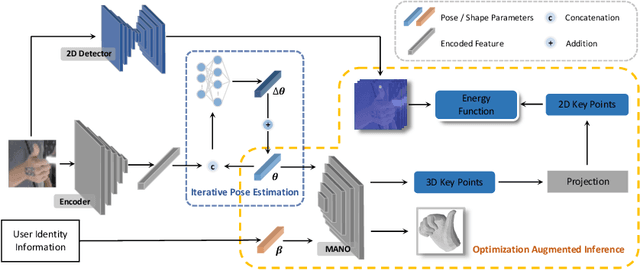
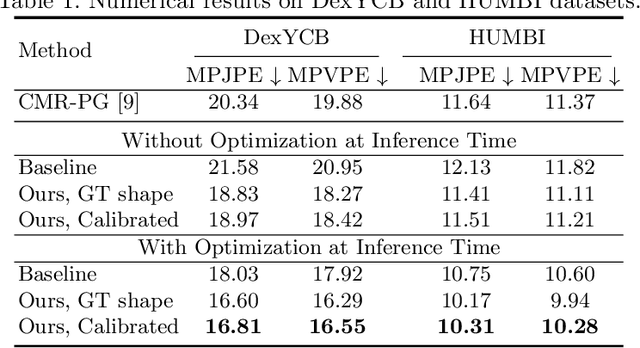
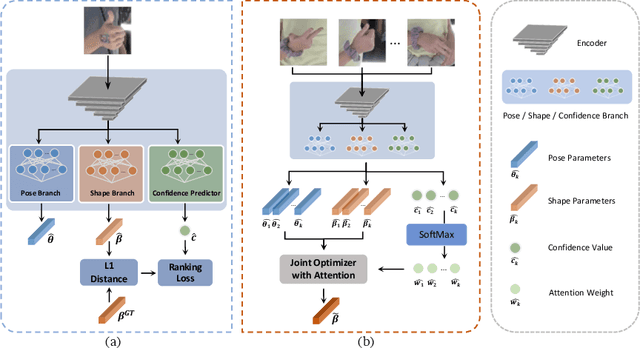

Abstract:Reconstructing 3D hand meshes from monocular RGB images has attracted increasing amount of attention due to its enormous potential applications in the field of AR/VR. Most state-of-the-art methods attempt to tackle this task in an anonymous manner. Specifically, the identity of the subject is ignored even though it is practically available in real applications where the user is unchanged in a continuous recording session. In this paper, we propose an identity-aware hand mesh estimation model, which can incorporate the identity information represented by the intrinsic shape parameters of the subject. We demonstrate the importance of the identity information by comparing the proposed identity-aware model to a baseline which treats subject anonymously. Furthermore, to handle the use case where the test subject is unseen, we propose a novel personalization pipeline to calibrate the intrinsic shape parameters using only a few unlabeled RGB images of the subject. Experiments on two large scale public datasets validate the state-of-the-art performance of our proposed method.
PPT: token-Pruned Pose Transformer for monocular and multi-view human pose estimation
Sep 16, 2022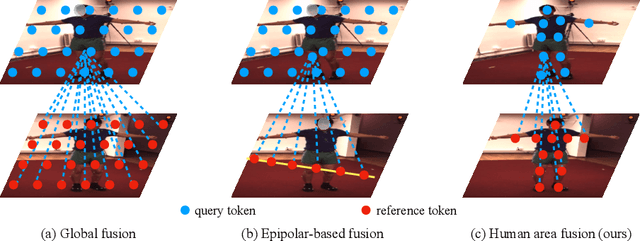
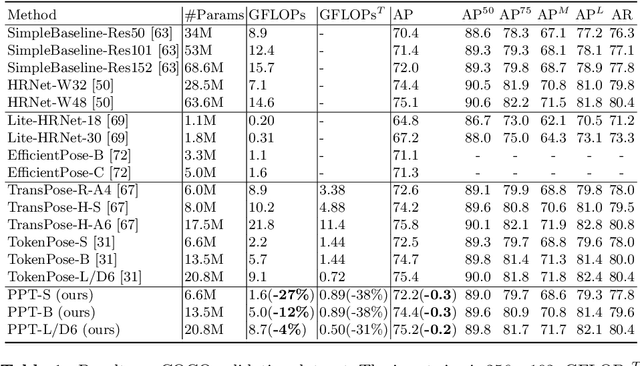


Abstract:Recently, the vision transformer and its variants have played an increasingly important role in both monocular and multi-view human pose estimation. Considering image patches as tokens, transformers can model the global dependencies within the entire image or across images from other views. However, global attention is computationally expensive. As a consequence, it is difficult to scale up these transformer-based methods to high-resolution features and many views. In this paper, we propose the token-Pruned Pose Transformer (PPT) for 2D human pose estimation, which can locate a rough human mask and performs self-attention only within selected tokens. Furthermore, we extend our PPT to multi-view human pose estimation. Built upon PPT, we propose a new cross-view fusion strategy, called human area fusion, which considers all human foreground pixels as corresponding candidates. Experimental results on COCO and MPII demonstrate that our PPT can match the accuracy of previous pose transformer methods while reducing the computation. Moreover, experiments on Human 3.6M and Ski-Pose demonstrate that our Multi-view PPT can efficiently fuse cues from multiple views and achieve new state-of-the-art results.
TransFusion: Cross-view Fusion with Transformer for 3D Human Pose Estimation
Oct 29, 2021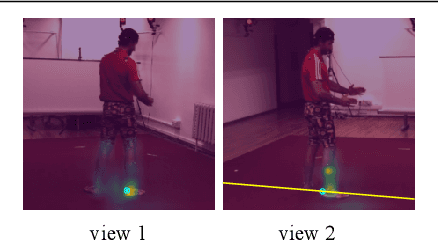



Abstract:Estimating the 2D human poses in each view is typically the first step in calibrated multi-view 3D pose estimation. But the performance of 2D pose detectors suffers from challenging situations such as occlusions and oblique viewing angles. To address these challenges, previous works derive point-to-point correspondences between different views from epipolar geometry and utilize the correspondences to merge prediction heatmaps or feature representations. Instead of post-prediction merge/calibration, here we introduce a transformer framework for multi-view 3D pose estimation, aiming at directly improving individual 2D predictors by integrating information from different views. Inspired by previous multi-modal transformers, we design a unified transformer architecture, named TransFusion, to fuse cues from both current views and neighboring views. Moreover, we propose the concept of epipolar field to encode 3D positional information into the transformer model. The 3D position encoding guided by the epipolar field provides an efficient way of encoding correspondences between pixels of different views. Experiments on Human 3.6M and Ski-Pose show that our method is more efficient and has consistent improvements compared to other fusion methods. Specifically, we achieve 25.8 mm MPJPE on Human 3.6M with only 5M parameters on 256 x 256 resolution.
MVHM: A Large-Scale Multi-View Hand Mesh Benchmark for Accurate 3D Hand Pose Estimation
Dec 06, 2020
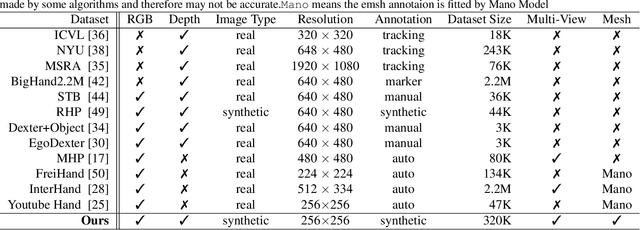

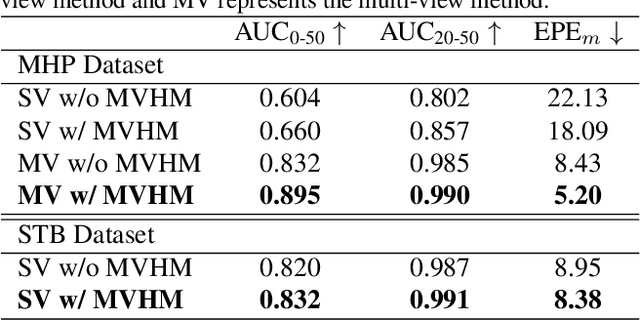
Abstract:Estimating 3D hand poses from a single RGB image is challenging because depth ambiguity leads the problem ill-posed. Training hand pose estimators with 3D hand mesh annotations and multi-view images often results in significant performance gains. However, existing multi-view datasets are relatively small with hand joints annotated by off-the-shelf trackers or automated through model predictions, both of which may be inaccurate and can introduce biases. Collecting a large-scale multi-view 3D hand pose images with accurate mesh and joint annotations is valuable but strenuous. In this paper, we design a spin match algorithm that enables a rigid mesh model matching with any target mesh ground truth. Based on the match algorithm, we propose an efficient pipeline to generate a large-scale multi-view hand mesh (MVHM) dataset with accurate 3D hand mesh and joint labels. We further present a multi-view hand pose estimation approach to verify that training a hand pose estimator with our generated dataset greatly enhances the performance. Experimental results show that our approach achieves the performance of 0.990 in $\text{AUC}_{\text{20-50}}$ on the MHP dataset compared to the previous state-of-the-art of 0.939 on this dataset. Our datasset is public available. \footnote{\url{https://github.com/Kuzphi/MVHM}} Our datasset is available at~\href{https://github.com/Kuzphi/MVHM}{\color{blue}{https://github.com/Kuzphi/MVHM}}.
Temporal-Aware Self-Supervised Learning for 3D Hand Pose and Mesh Estimation in Videos
Dec 06, 2020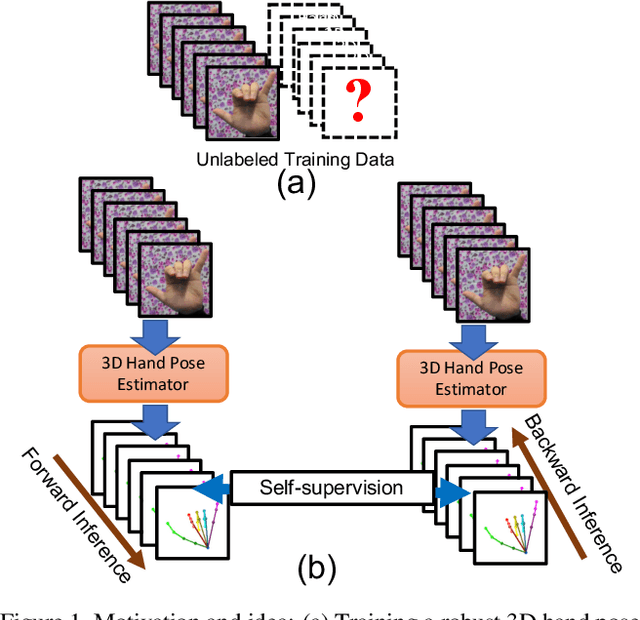


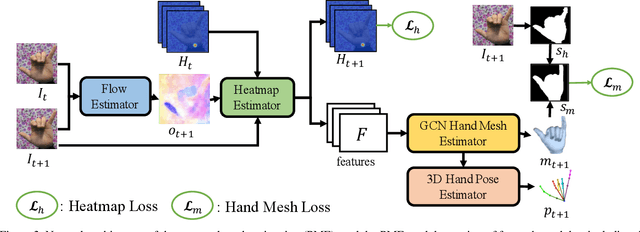
Abstract:Estimating 3D hand pose directly from RGB imagesis challenging but has gained steady progress recently bytraining deep models with annotated 3D poses. Howeverannotating 3D poses is difficult and as such only a few 3Dhand pose datasets are available, all with limited samplesizes. In this study, we propose a new framework of training3D pose estimation models from RGB images without usingexplicit 3D annotations, i.e., trained with only 2D informa-tion. Our framework is motivated by two observations: 1)Videos provide richer information for estimating 3D posesas opposed to static images; 2) Estimated 3D poses oughtto be consistent whether the videos are viewed in the for-ward order or reverse order. We leverage these two obser-vations to develop a self-supervised learning model calledtemporal-aware self-supervised network (TASSN). By en-forcing temporal consistency constraints, TASSN learns 3Dhand poses and meshes from videos with only 2D keypointposition annotations. Experiments show that our modelachieves surprisingly good results, with 3D estimation ac-curacy on par with the state-of-the-art models trained with3D annotations, highlighting the benefit of the temporalconsistency in constraining 3D prediction models.
DGGAN: Depth-image Guided Generative Adversarial Networks for Disentangling RGB and Depth Images in 3D Hand Pose Estimation
Dec 06, 2020



Abstract:Estimating3D hand poses from RGB images is essentialto a wide range of potential applications, but is challengingowing to substantial ambiguity in the inference of depth in-formation from RGB images. State-of-the-art estimators ad-dress this problem by regularizing3D hand pose estimationmodels during training to enforce the consistency betweenthe predicted3D poses and the ground-truth depth maps.However, these estimators rely on both RGB images and thepaired depth maps during training. In this study, we proposea conditional generative adversarial network (GAN) model,called Depth-image Guided GAN (DGGAN), to generate re-alistic depth maps conditioned on the input RGB image, anduse the synthesized depth maps to regularize the3D handpose estimation model, therefore eliminating the need forground-truth depth maps. Experimental results on multiplebenchmark datasets show that the synthesized depth mapsproduced by DGGAN are quite effective in regularizing thepose estimation model, yielding new state-of-the-art resultsin estimation accuracy, notably reducing the mean3D end-point errors (EPE) by4.7%,16.5%, and6.8%on the RHD,STB and MHP datasets, respectively.
MM-Hand: 3D-Aware Multi-Modal Guided Hand Generative Network for 3D Hand Pose Synthesis
Oct 02, 2020


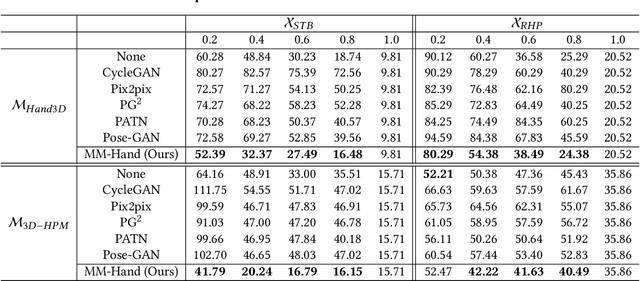
Abstract:Estimating the 3D hand pose from a monocular RGB image is important but challenging. A solution is training on large-scale RGB hand images with accurate 3D hand keypoint annotations. However, it is too expensive in practice. Instead, we have developed a learning-based approach to synthesize realistic, diverse, and 3D pose-preserving hand images under the guidance of 3D pose information. We propose a 3D-aware multi-modal guided hand generative network (MM-Hand), together with a novel geometry-based curriculum learning strategy. Our extensive experimental results demonstrate that the 3D-annotated images generated by MM-Hand qualitatively and quantitatively outperform existing options. Moreover, the augmented data can consistently improve the quantitative performance of the state-of-the-art 3D hand pose estimators on two benchmark datasets. The code will be available at https://github.com/ScottHoang/mm-hand.
Generating Realistic Training Images Based on Tonality-Alignment Generative Adversarial Networks for Hand Pose Estimation
Nov 27, 2018



Abstract:Hand pose estimation from a monocular RGB image is an important but challenging task. The main factor affecting its performance is the lack of a sufficiently large training dataset with accurate hand-keypoint annotations. In this work, we circumvent this problem by proposing an effective method for generating realistic hand poses and show that state-of-the-art algorithms for hand pose estimation can be greatly improved by utilizing the generated hand poses as training data. Specifically, we first adopt an augmented reality (AR) simulator to synthesize hand poses with accurate hand-keypoint labels. Although the synthetic hand poses come with precise joint labels, eliminating the need of manual annotations, they look unnatural and are not the ideal training data. To produce more realistic hand poses, we propose to blend a synthetic hand pose with a real background, such as arms and sleeves. To this end, we develop tonality-alignment generative adversarial networks (TAGANs), which align the tonality and color distributions between synthetic hand poses and real backgrounds, and can generate high quality hand poses. We evaluate TAGAN on three benchmarks, including the RHP, STB, and CMU-PS hand pose datasets. With the aid of the synthesized poses, our method performs favorably against the state-of-the-arts in both $2$D and $3$D hand pose estimations.
Structured Triplet Learning with POS-tag Guided Attention for Visual Question Answering
Jan 24, 2018



Abstract:Visual question answering (VQA) is of significant interest due to its potential to be a strong test of image understanding systems and to probe the connection between language and vision. Despite much recent progress, general VQA is far from a solved problem. In this paper, we focus on the VQA multiple-choice task, and provide some good practices for designing an effective VQA model that can capture language-vision interactions and perform joint reasoning. We explore mechanisms of incorporating part-of-speech (POS) tag guided attention, convolutional n-grams, triplet attention interactions between the image, question and candidate answer, and structured learning for triplets based on image-question pairs. We evaluate our models on two popular datasets: Visual7W and VQA Real Multiple Choice. Our final model achieves the state-of-the-art performance of 68.2% on Visual7W, and a very competitive performance of 69.6% on the test-standard split of VQA Real Multiple Choice.
 Add to Chrome
Add to Chrome Add to Firefox
Add to Firefox Add to Edge
Add to Edge